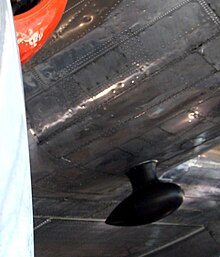
An automatic direction finder (ADF) is a marine or aircraft radio-navigation instrument that automatically and continuously displays the relative bearing from the ship or aircraft to a suitable radio station.[3][4] ADF receivers are normally tuned to aviation or marine NDBs (Non-Directional Beacon) operating in the LW band between 190 – 535 kHz. Like RDF (Radio Direction Finder) units, most ADF receivers can also receive medium wave (AM) broadcast stations, though these are less reliable for navigational purposes.
The operator tunes the ADF receiver to the correct frequency and verifies the identity of the beacon by listening to the Morse code signal transmitted by the NDB.[5] On marine ADF receivers, the motorized ferrite-bar antenna atop the unit (or remotely mounted on the masthead) would rotate and lock when reaching the null of the desired station. A centerline on the antenna unit moving atop a compass rose indicated in degrees the bearing of the station. On aviation ADFs, the unit automatically moves a compass-like pointer (RMI) to show the direction of the beacon. The pilot may use this pointer to home directly towards the beacon, or may also use the magnetic compass and calculate the direction from the beacon (the radial) at which their aircraft is located.
Unlike the RDF, the ADF operates without direct intervention, and continuously displays the direction of the tuned beacon. Initially, all ADF receivers, both marine and aircraft versions, contained a rotating loop or ferrite loopstick aerial driven by a motor which was controlled by the receiver. Like the RDF, a sense antenna verified the correct direction from its 180-degree opposite.
More modern aviation ADFs contain a small array of fixed aerials and use electronic sensors to deduce the direction using the strength and phase of the signals from each aerial. The electronic sensors listen for the trough that occurs when the antenna is at right angles to the signal, and provide the heading to the station using a direction indicator. In flight, the ADF's RMI or direction indicator will always point to the broadcast station regardless of aircraft heading. Dip error is introduced, however, when the aircraft is in a banked attitude, as the needle dips down in the direction of the turn. This is the result of the loop itself banking with the aircraft and therefore being at a different angle to the beacon. For ease of visualisation, it can be useful to consider a 90° banked turn, with the wings vertical. The bearing of the beacon as seen from the ADF aerial will now be unrelated to the direction of the aircraft to the beacon.
Dip error is sometimes wrongly confused with quadrantal error, which is the result of radio waves being bounced and reradiated by the airframe. Quadrantal error does not affect signals from straight ahead or behind, nor on the wingtips. The further from these cardinal points and the closer to the quadrantal points (i.e. 45°, 135°, 225° and 315° from the nose) the greater the effect, but quadrantal error is normally much less than dip error, which is always present when the aircraft is banked.
ADF receivers can be used to determine current position, track inbound and outbound flight path, and intercept a desired bearing. These procedures are also used to execute holding patterns and non-precision instrument approaches.
- ^ AN 01-40NC-2 Handbook Erection and Maintenance Instructions. U.S. Air Force. 15 October 1944. Retrieved 4 August 2014.
- ^ May, Joseph (8 January 2013). "Flagship Knoxville — an American Airlines Douglas DC-3". Hearst Seattle Media. Retrieved 3 August 2014.
- ^ Federal Aviation Administration (2008). "Chapter 15: Navigation" (PDF). Pilot's Handbook of Aeronautical Knowledge (PDF). US Dept. of Transportation. ISBN 978-1-56027-783-5. Archived from the original (PDF) on 18 June 2015. Retrieved 14 September 2015.
- ^ Civil Aviation Safety Authority (2005). "Operational Notes on Non-Directional Beacons (NDB) and Associated Automatic Direction Finding (ADF)" (PDF). Government of Australia. Archived from the original (PDF) on 30 May 2009. Retrieved 11 February 2011.
- ^ Latifiyan, Pouya (2022). "NDB in Aviation". Aviation Telecommunication Specialized Conference 2022. 6. Tehran: Civil Aviation Technology College.